Getting to the teaching garden
The Schuyler County Cooperative Extension Teaching Garden is located on the north side of the the Schuyler County Human Services Complex building (where our office is!). The address is
323 Owego StreetMontour Falls, New York 14865
Type the address above into your favorite GPS or navigation app for directions, or click the address for Google Map directions.
Welcome!
The Schuyler County Cooperative Extension Teaching Garden is a place created to encourage positive lifestyle changes through the learning process of gardening. We’ve created this self-guided tour so you can still learn about the hidden gems this garden has to offer while maintaining proper physical distance. Even though our garden might not be as upkept as it has been in previous years, take a closer look to see nature’s beauty.
Stop 1
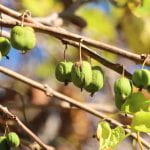
|
Kiwi ArborActinidia arguta, commonly known as hardy kiwi or tara vine, is a deciduous, fast-growing, twining woody vine usually grown for its attractive foliage and edible fruit. It is native to woodlands, mountain forests, stream banks, and moist locations in eastern Asia, China and Japan. It grows to 25-30′ or more. In our garden, it creates the shade we need to enjoy our picnic tables. |
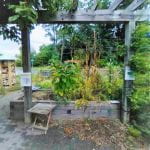
|
Raised BedsRaised beds bring the planting area above the ground, reduce soil compaction, improve drainage, and prevent weeds. They also make it easier for people with disabilities or mobility issues to garden. Because of our raised beds and hard-surfaced paths, people from the ARC can garden here. More information about raised beds: |
Stop 2

|
Bee HotelThis structure’s shelves have nesting material to attract native solitary bees. Unlike the honey bees or bumble bees, solitary bees don’t live in a hive, sting, or make honey. Solitary bees are great pollinators — they can do so better than honey bees! Unfortunately, many of the 400+ bee species in NYS are more sensitive to environmental changes than honey bees, and their numbers may be declining. That’s why providing habitat for wild bees, like this bee hotel does, is important! More information about wild bees: |
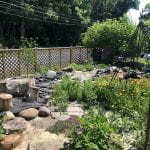
|
Head Start GardenThe Schuyler County Head Start wanted their outdoor play area to provide unstructured nature-based play. With the help of a grant, they created a kid-friendly area within our teaching garden. It allows for spontaneous outdoor play, an appreciation for the living things and a connection to the natural world. |

|
Pollinator GardenThe plants here have a wide variety of shapes, sizes and blooming dates to attract many different pollinators. We also don’t keep this garden ‘tidy.’ Leaf litter, plant stems, and undisturbed soils are habitats for beneficial insects. Depending on the time of year, you might find plants including Culver’s Root, Purple Coneflower, Wild Bergamot, Yarrow, and Mexican Sunflower. |
Stop 3
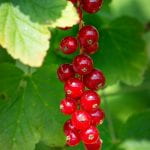
|
CurrantsBecause of their tartness, people usually mix currants into juices, jams, and jellies, rather than eating them fresh. Currants are a great superfood and are loaded with vitamin C and antioxidants. NYS banned currants until as late as 2003 because currants can host a fungus that infects trees. More information about currants: |
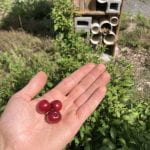
|
Bush CherriesDesigned to grow on the prairies of Canada, the University of Saskatchewan produced these bush cherries. Their fruit is tart, deep red in color, has a high sugar content and lots of antioxidants. More information about bush cherries: |

|
GooseberriesWhen ripe, gooseberries are very sweet and reddish purple in color, great for jams or berry sauces. Gooseberries are even edible when unripe – the green berries are particularly tart and great for pies and desserts. A one cup serving of gooseberries provides about half your daily value of vitamin C, and a quarter of your daily fiber. More information about gooseberries: |
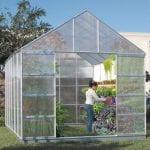
|
Site of Future GreenhouseAn outdoor greenhouse allows us to create hands-on classrooms for Head Start youth where math and science projects unfold. Master Gardeners can show students how to grow food while providing a source of veggies for school meals. They can also become an integral part of our community garden. |
Stop 4
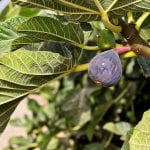
|
FigsFigs are sweet, soft, and chewy, and have crunchy, edible seeds throughout. They spoil easily and are often dried. Figs and their leaves offer many health benefits. They can promote healthy digestion, decrease the risk of heart disease, and help manage blood sugar levels. More information about figs: |

|
CompostCompost is rich decomposing organic matter that improves soil quality and helps plants grow better without chemicals. We compost to reduce our garden waste, improve our soil, and reduce our need for fertilizers. More information about compost: |

|
Manchurian ApricotAlso known as bush apricots, these trees can act as small windbreaks, provide nesting sites for songbirds. Their fruits are used fresh, processed, or dried. Apricots provide phloretin, an antibiotic, and are sometimes used for coughs, colds, gout, and cancer research. |
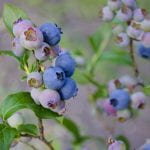
|
BlueberriesBlueberries are low in calories because they have less sugar than other fruits. They’re also full of nutrients and antioxidants. Blueberries can help prevent age-related diseases, lower blood pressure, reduce the risk of heart disease, fight against diabetes, and help maintain brain function. More information about blueberries: |
Stop 5
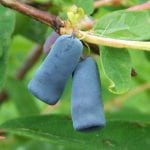 Opioła Jerzy / CC-BY-2.5 |
Honeyberry TrialWhile they’re new to European and North American gardeners, cooler Asian and Eastern European regions have cultivated honeyberries for centuries. Honeyberries are related to honeysuckle bushes but have edible fruits. The grape-shaped berries have more antioxidants than blueberries and can taste like blackberries, cherries, grapes, or kiwis. Honeyberries are hardy, grow well in poor soils, and ripen early in the spring – even before strawberries! More information about honeyberries: |
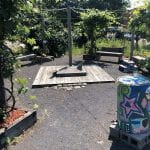
|
Outdoor ClassroomBeing the most central spot in our garden, this outdoor stage with bench seating allows us to teach from a central platform. We use the 4 raised beds along the perimeter of the classroom for teaching programs. We’re also trialing grapes in our outdoor classroom which provide a natural shade canopy. |
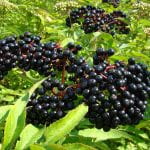 Edal Anton Lefterov / CC-BY-SA-3.0 |
ElderberryElderberries are dark purple and grow in bunches. They aren’t edible raw – the berries contain toxins that cooking removes. The berries are good in jams, jellies, syrups, pies, juice, and even wine. Elderberries are loaded with vitamin A, C, antioxidants, and fiber. Eating elderberry can reduce the duration and severity of cold and flu and upper respiratory symptoms. They may even reduce cholesterol and blood sugar. More information about elderberries: |
Stop 6
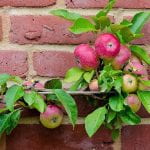
|
Apple Espalier“Fruit walls” of espaliered trees first appeared in mid-16th-century Europe. Espaliered fruit trees grow flat against a wall, fence, or trellis. Our espaliered apple trees give our garden a natural fence while enjoying several varieties of apples all while taking up very little space in our garden. More information about espaliers: |
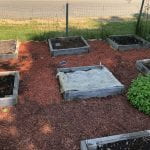
|
CU Veggie Variety TrialsThe Vegetable Variety Trial Garden Project (VVTG) is for CCE programs and affiliates across NYS who grow veggie demonstration gardens. The VVTG’s goal is to find which cultivars are best for growing in NYS. More information about the program: |
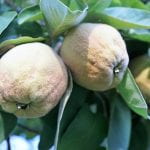
|
Quince of RussiaQuince trees have been cultivated in Turkey and Southeast Asia for centuries. Their fruits look and grow similarly to pears. But, unlike pears, they are almost inedible when eaten raw because of their tough, spongy, bitter fruit. But their high levels of Vitamin C and pectin make them a great fruit to eat cooked. Quinces can be eaten boiled, poached, stewed, or baked, and can be used for jams, jellies, baked goods, and canning. When stewed in a little sugar and water, quinces become soft, tender, flavorful, and fragrant. More information about quinces: |
Stop 7
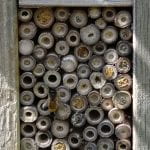
|
Shade Pollinator GardenYou can still do your part to help pollinators! While bees and butterflies need the warm sun in the morning to dry the dew off their wings, they can oftentimes be found seeking the refuge of shade in the hot afternoon. A large variety of blooms, both sun-loving and shade-loving, can draw a wide variety of pollinators. |
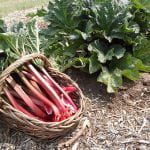 RhubarbFarmer / CC-BY-SA-3.0 |
RhubarbTechnically a vegetable, like celery, the stalks of the rhubarb plant are legally – and commonly eaten as – a fruit. While you can eat the bright pink stalks when they’re ripe in April to June, you can’t eat the leaves – they’re quite toxic! Because the stalks are very tart and tough when raw, they’re often cooked and sweetened with sugar, and then eaten in jams, sauces, pies, tarts, and baked goods. While rhubarb is low in calories and in some essential nutrients, rhubarb counters with loads of fiber and antioxidants. More information about rhubarb: |
Stop 8
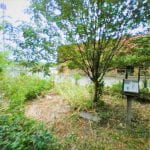
|
Amelia J. Cornish Memorial GardenMrs. Cornish passed at the age of 93 and was a member of the Schuyler County Solid Waste Management Task Force, Schuyler County Environmental Task Force, and the Schuyler County Historical Society. Her achievements included supporting conservation, animal welfare and the environment and establishing the local recycling program This memorial stands for all the years of service to Schuyler County! |
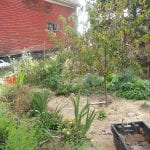 Gandydancer / CC-BY-SA-3.0 |
Permaculture GuildPermaculture is the incorporation of ecological principles into gardens, farms, homesteads, and urban sites. A Guild is any group of species that exploit the same resources, often in related ways. Guilds are groups of plants, animals, insects, etc. that work well together. Our permaculture guild contains groups of plants that reduce the garden’s maintenance and inputs. |
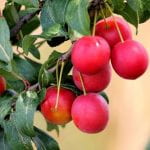
|
Cherry PlumThe cherry plum tree’s unique color makes it a popular ornamental tree. Cherry plums contain substances that break down in water to form hydrocyanic acid, which stimulates the body’s respiration, improves digestion, and improves overall health. The fruits are edible and are a good source of potassium, calcium, phosphate, vitamin B and C, which help the body’s metabolism and nervous system. They can be used for pies, jams, tarts, and more. More information about cherry plums: |




